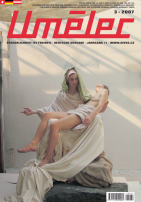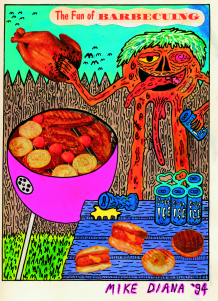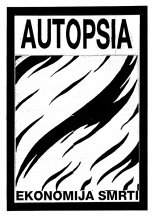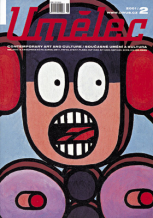| Umělec 2007/3 >> SLAVEN TOLJ | Просмотр всех номеров | ||||||||||||
|
|||||||||||||
SLAVEN TOLJUmělec 2007/301.03.2007 Katarína Rusnáková | profile | en cs de es |
|||||||||||||
|
Though already one of the most significant contemporary artists on the Croatian scene, Slaven Tolj—a multimedia artist, organizer of art activities and curator—has recently achieved international recognition for his inconspicuous Ready-mades, installations, photography, and performances presenting distinct political and social- -cultural criticism.
In the spring of 2007, Tolj’s work was presented at the Usti Nad Labem gallery in the Czech Republic, in a solo exhibition entitled “Untitled Perspective…” curated by Michal Koleček. This show offered audiences unfamiliar with Slaven Tolj’s work an opportunity to view a variety of works, all of which are integral of his creative profile. Though he built his notoriety as an author in the Czech Republic through international curatorial projects and small presentations of his work, it was through collaboration with Koleček that Tolj was able to show the structured artistic pieces of “Untitled Perspective…” in Prague and Brno. Tolj graduated from the Academy of Fine Arts in Sarajevo as a graphic artist in 1987. He was heavily influenced and radicalized by the Yugoslav Wars, especially the resulting break-up of Yugoslavia. In the hectic period following the fall of the Berlin Wall and consequential collapse of the Soviet Union—a time when post-totalitarian states began to flourish with a rich variety of political, economic, social, and cultural ideas—the Balkan region started to crumble, with its complete deterioration heralded by the beginning of the Nineties. The cruelty of ethnic and religious intolerance, intensified by the virus of nationalist populism, led to conflict in 1991. Tolj joined the war in 1992-1993 during the siege by the Yugoslav siege of Dubrovnik in southern Croatia. Though he suffered from painful experiences and post-traumatic shock, to an extent that their expression has become definitive of his style, Tolj was able to find further inspiration in that resort town, which he saw as a symbol of civilization, as well as urban and natural beauty. Tolj’s personal relationship with this place is represented by an “iconosphere” (his own personal iconic visual language) tattooed on his left shoulder. Like an archeologist, Tolj explores fragments of individual, collective and cultural memory, all of which he relates to the spirit of Dubrovnik. With analytical precision, Tolj selects the placement of his ready-mades; these are site specific installations or “discovered” paintings that he then captures as photographs. He integrates these objects with his own memories, though he refrains from working with those from his youth in the liberal era of former Yugoslavia. The majority of his work calls not only upon physical and mental stigmas caused by the ethnic wars, but offer contemporary social criticism as well. Tolj also explores the unappeasable appetites of consumerism and the tourist industry, both of which sacrifice cultural values and local context for profit. Tolj still maintains a close relationship to the vicissitudes of his hometown; he internalizes the unavoidable political turbulences of his native region as if they were his own. Slaven Tolj’s artistic style may best be described as neo-conceptualist. He not only follows in the footsteps of Marcel Duchamp, he incorporates into his work techniques related to action art, appropriation and postproduction as well. One of Tolj’s main aims is to initiate his audience into multi-layered perception, because he considers art perception as a multidimensional process of communication based on the mutual exchange of information and inter-textual discourse, where the individual should reach a harmony of reflection and spirituality. Likewise, he refuses to abandon his idealistic faith that art contains the potential to activate change for the betterment of society. “BEFORE AND AFTER” AND THE PARADOXES OF THE BALKANS The contextual aspect of art is often the main criterion in understanding Eastern European art, which strives to mediate a specific message. Scholar Barbara Barschova notes that Eastern art is introverted (focused inwards) and that’s a criterion of quality. She explains that one can occasionally find art works that are “just for fun,” but it is even harder to find pieces with no political point, for they usually have a deeper contextual meaning in reaction to the absurdity of everyday triviality. Let’s examine the phenomenon called Central and Eastern European art. ART OF CENTRAL EUROPE This term is widely used; but its political and geographical sense tends to be confused with cultural meaning. Even so, the term Eastern Europe is today totally bereft of its geographical meaning, which even now has not disappeared. As such, the cultural specifics of Central Europe are over-looked, and united with those of the eastern parts of Europe, despite clear differences from Russians, Bulgarians or Romanians. The distinction arises from the ideological political systems settling for half a century in countries such as Poland, Bulgaria, Romania, the former Czechoslovakia, Hungary, former Yugoslavia, and other formal imperial lands of the Soviet Union. Indeed, Central Europe is an artificial construction, resulting from searches for specifics of cultural identity, but also arose from a need to exit the narrow framework of small xenophobic national cultures to find general, uniting cultural components of small languages and literatures in the territory of Central Europe. From a cultural-historical view, the CzechRepublic, Slovakia, Hungary, Poland and former Yugoslavian countries have always been contextualized as Central European. Czech author Milan Kundera writes of a shared Central European experience, from which groups of artists draw from the “same memories, same problems and same conflicts in a common tradition.” After diplomatic relations between Yugoslavia and the Soviet Union were cut off in 1948, Yugoslavia refused to accept the doctrine of Socialist Realism; therefore, underground society never had the opportunity to develop a consistent alternative or parallel culture with dissidents. Yugoslavian cultural politics were liberal to the extent that artists could contact and cooperate with artists in Western Europe (such as Joseph Beuys in Belgrade in 1974), participate in artistic partnerships (Mariana Abramovic with Ras Todosijevic) or even freely travel to western countries. The subsequent disintegration of art and culture from the Yugoslav Wars was particularly tragic, as destruction in Croatia and Bosnia coincided with the extinction of the Yugoslavian, multicultural context that had been developing for fifty years. The Balkan ethnic wars of the 1990s created a mass of emigrants who were left no choice but to define their worlds through the framework of borders. Exiled since 1993, Croatian writer Duravka Ugresicova examines the Yugoslav/Balkan wars: “There is an experience of mixed cultures, a rural and urban experience of cultural cosmopolitism and sincere ‘xenomania,’ but also an experience of cultural autism and angry xenophobia that is a result of war, division and making of new states, the experience of chaos, blood, death and devastation, the experience of a lie and the experience of multiplied banishment.” The Yugoslav war was a violent failure of human solidarity and resulted in horrible losses still visible in everyday life. Thousands of people paid for new “symbols of identity” with their lives, thousands have been expelled from their lives, and thousands have been expelled from their homes, humiliated, robbed and impoverished. This digression serves to better contextualize the opinions and civil attitudes of Slaven Tolj, inscribing them within the political, social and cultural development of Central Europe. Tolj demonstrates that global conflict can be the key that triggers the mechanisms of artistic creativity; when an artist comes to terms with such a conflict of rising evil, that can also bring about favorable therapeutic effects. ARCHEOLOGY OF MEMORIES: INTERSECTION OF PAST AND PRESENT Let’s now narrow our focus to examine some of Tolj’s art works. The photographic project Interrupted Game (1993) is a model example of contextual art. Factual, black and white photos capture found scenes, like white tennis balls stuck between columns of Dubrovnik’s cathedral pillars, outside of which children used to play tennis. These views bring nostalgic associations of the calm before wartime and contrast with the emptiness of this same space during the blockade and bombing of Dubrovnik. Tolj associated himself with another church, Jesuit’s St. Ignatius, through his site-specific installation Untitled (1997). Though not a part of “Untitled Perspective…” Untitled is nonetheless an important work of Tolj. Made from two simple spherical lamps, a part hung from the ceiling of the Kulturbahnof in Kassel (1997) at the document X exhibition. While Dubrovnik was under fire, these two lamps substituted for St. Ignac’s Baroque chandeliers; once they had served their utilitarian purpose, Tolj re-appropriated the lamps as ready-mades, with invisible scars of war, and brought them to the liberal democratic environment of Germany. Curator Michal Koleček gives an apt description of Tolj’s work: “Inside the western world, Tolj presented symbols connected with the event of war to point out the fact that significant conflicts are usually prefigured and represented by processes and symbols that are not easily recognizable. Another canonic hint/allusion of the unhealthy, claustrophobic space in Dubrovnik during the siege was a fan that functioned without protective case, named Bubo Bubo Maximus, which Tolj locked in a glass museum vitrine.” Tolj has also created a site-specific installation, dependant on audience participation, titled Cinema Jadran, which was shown from 1993-2007. The piece alluded to the popular Yardan cinema, frequented by Tolj, which was forced to halt its operations under the auspices of the proverb “inter arma silent musae,” or “the muses are silent amongst war.” He reconstructed a small cinema, complete with an old film projector, but did not supply the projector with film; the immaterial square of flickering light evoked a sense of waiting for a movie (which ultimately never appeared) following the form of Beckett’s absurd drama. Anyone from the audience could sit in an old wooden chair in the gloom of an impoverished cinema, and project his or her own mental movie onto the vacant screen. Light, as a phenomenon, with all its reflections and its fixtures, is often granted great significance in Tolj’s work. Light is not only featured in his work, but is carefully crafted to create specific, nuanced atmospheres in architectural spaces (see Tolj’s untitled colored photographs, 1997). Tolj was able to express his memories, skepticism and depression in his piece Untitled (2005), by removing the reflective mirror grid from the surface of a disco ball. According to Koleček, the stripped disco ball represents the disillusion of the 80s generation resulting from the post-totalitarian transformation. Joy in illusion and entertainment had been sacrificed to the bitter and devastating reality of life in the different political and social conditions of “new society.” A humorous piece of the artist’s moderate aesthetic is a piece of blue cloth, probably cut out from some marchioness bleached by the sun, accompanied with “action” marks formed from bird droppings named. Entitled Una Bella Avola (1993), the work fit well on a white wall, nicely resembling abstract painting with a marine theme. Tolj has also presented a number of radical performances. It’s clear from recordings that the artist pushes himself to his physical limitations, putting himself through self-imposed, health-threatening “ordeals” for the sake of his body-art performances. In his performance Nature and Society (2002), at the opening of the “Here Tomorrow” exhibition in Zagreb, Croatia, Tolj attempted to reconcile his family history with his own identity. Naked and crowned with his grandfather’s stag antlers, Tolj repeatedly crashed into a wall, a process that he described as “an attempt, a need, a wish, a plea to leave behind male ideology of the society and family – to leave behind, to stop, to finish, to define one male history (misfortune) that transfers from one generation to another.” By the conclusion of the piece, Tolj both destroyed the antlers and damaged his own spine. In 2001, Tolj presented his self-destructive performance Globalization (2001) at the Exit Art Gallery in New York, as a part of the “Body and the East” exhibition. Globalization was a minimalist performance lasting for several hours, during which Tolj sat calmly at a table, slowly drinking a mixture of Russian vodka and American whiskey, and eventually ended with his hospitalization for alcohol poisoning. Tolj spent two days in a coma, turning himself into a human warning of the perils of globalization, and almost sacrificed his life for his art. For his final piece at the Usti nad Labem exhibition, Tolj showed Marking (2007), a sophisticated and symbolic video installation reminiscent of Duchamp’s Entant donnes: 1° La chute d’eau, 2° Le gaz d’eclairage (1946-1966), in terms of its formal and architectural structure. Through a spy-hole in a door, one could see a black-andwhite TV screen showing the end of a TV station broadcast, complete with the state flag and musical accompaniment of the national anthem; a common custom of most public TV channels around the world, though specifically Croatian in Marking. Tolj reduced and trapped the color range of the Croatian national flag in black-and-white to lend the piece the spirit of critical models which reveal the relationship between art, politics, institutions and social behavior— all themes of importance in the texts of German conceptual artist and writer Hans Haacke, among many others. On the other hand, he considers the horizontal black and white stripes of the flag to represent the black bands that people in mourning wear, which bring about associations of sorrow with semantic messages in overlapping local context. In Croatian artist Antun Maračić’s catalogue text for Tolj’s Dubrovnik exhibition, he suggests that the miniaturization of an image seen through binocular glasses underlines an expression of distance between subjects; their own personal space and the metropolis represented by this national symbol. In this way, he references all disillusions and social deformations caused by war. Tolj’s obsessive topic of Dubrovnik as a specific tropus expands into more semantic layers. Tolj applies his personal approach to his endeavors as a curator and organizer with the same dedication he shows in his art. Since 1988, he has headed the Lazareti Art Workshop in Dubrovnik – an important non-profit Croatian center of contemporary art, focusing on gallery work presenting Croatian and foreign artists. The Lazareti Art Workshop also features an open forum, residential programs, organized movie screenings, musicals and theatrical performances (such as the Caranten festival). Tolj contributes significantly to the propagation and exposure of the Croatian art scene, in both the surrounding Balkans and internationally, such as in 2005 when he curated an exhibit of contemporary Croatian art at Bienace, Venice. Slaven Tolj’s art works have been part of renowned international exhibitions including “Body and the East,” a survey of the past 40 years of body art performances from the former East Block and the Soviet Union, which was seen in Ljubljana, Slovenia and Manhattan. It is clear that the story of Slaven Tolj is not only an example of individual creative efforts within the visual art world; it is also an intensive exploration into the human condition, and represents a powerful example in the context of contemporary art, where the artist hasn’t abandoned the possibilities found linking ethics with aesthetics.
01.03.2007
Рекомендуемые статьи
|
|||||||||||||
|
04.02.2020 10:17
Letošní 50. ročník Art Basel přilákal celkem 93 000 návštěvníků a sběratelů z 80 zemí světa. 290 prémiových galerií představilo umělecká díla od počátku 20. století až po současnost. Hlavní sektor přehlídky, tradičně v prvním patře výstavního prostoru, představil 232 předních galerií z celého světa nabízející umění nejvyšší kvality. Veletrh ukázal vzestupný trend prodeje prostřednictvím galerií jak soukromým sbírkám, tak i institucím. Kromě hlavního veletrhu stály za návštěvu i ty přidružené: Volta, Liste a Photo Basel, k tomu doprovodné programy a výstavy v místních institucích, které kvalitou daleko přesahují hranice města tj. Kunsthalle Basel, Kunstmuseum, Tinguely muzeum nebo Fondation Beyeler.
|



































 New book by I.M.Jirous in English at our online bookshop.
New book by I.M.Jirous in English at our online bookshop.
Комментарии
Статья не была прокомментированаДобавить новый комментарий